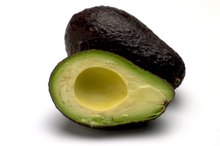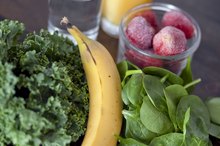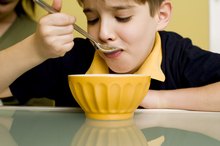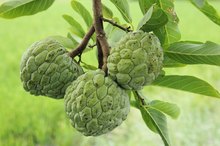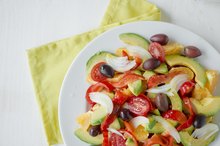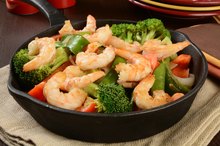What does fact checked mean?
At Healthfully, we strive to deliver objective content that is accurate and up-to-date. Our team periodically reviews articles in order to ensure content quality. The sources cited below consist of evidence from peer-reviewed journals, prominent medical organizations, academic associations, and government data.
- Office of Dietary Supplements: Iron
- National Heart, Lung and Blood Institute: Iron-Deficiency Anemia
- National Heart, Lung and Blood Institute: Iron-Deficiency Anemia
The information contained on this site is for informational purposes only, and should not be used as a substitute for the advice of a professional health care provider. Please check with the appropriate physician regarding health questions and concerns. Although we strive to deliver accurate and up-to-date information, no guarantee to that effect is made.
Do Avocados Have Lots of Iron in Them?
Avocados are a delicious, albeit peculiar, fruit. The flavor, texture and nutrient profile of avocados differ significantly from other kinds of fruit. Iron is one of the many essential nutrients in avocados. This mineral has an affinity for oxygen and is highly chemically reactive. Your body requires iron to produce erythrocytes, or red blood cells. Your muscles also use iron to bind oxygen.
Iron Content
The two forms of iron present in food are heme and nonheme iron. Heme iron comes from animal-derived foods, and nonheme iron comes from plants. Avocados contain a moderate amount of the nonheme form of iron, which is less well absorbed from your intestines than heme iron. A whole avocado contains approximately 1.1 to 1.7 mg of iron, depending on the size of the fruit. A cup of mashed avocado contains roughly 1.3 mg of iron. The recommended daily intake for iron is 18 mg for women of childbearing age and 8 mg for men and postmenopausal women. A dietary iron deficiency may lead to reduced red blood cell production and anemia 3.
- The two forms of iron present in food are heme and nonheme iron.
- Avocados contain a moderate amount of the nonheme form of iron, which is less well absorbed from your intestines than heme iron.
Optimizing Iron Absorption
Fatty Fruit
Learn More
The food you eat with avocados influences your intestinal absorption of nonheme iron from this fruit. Eating meat with avocados improves iron absorption. A sandwich with turkey breast and avocado slices, for example, is a good pairing of foods to enhance iron absorption. Vitamin C-rich foods -- such as citrus fruit, sweet green peppers, broccoli and Brussels sprouts -- also enhance nonheme iron absorption.
- The food you eat with avocados influences your intestinal absorption of nonheme iron from this fruit.
Cooking with Avocados
Guacamole is one of the most popular uses of avocados, but you can include this fruit in many other dishes to boost your iron intake. Sliced or cubed avocado is an attractive and tasty addition to pasta, fruit and vegetable salads. Use pureed avocados to make salad dressings, sauces and soups. The flavor of avocados complements seafood dishes, and the texture works well in smoothies.
- Guacamole is one of the most popular uses of avocados, but you can include this fruit in many other dishes to boost your iron intake.
- Sliced or cubed avocado is an attractive and tasty addition to pasta, fruit and vegetable salads.
Other Nutrients in Avocados
Are Mangoes Good for Dieting?
Learn More
You may be hesitant about including avocados in your nutrition plan due to the fact that they contain a large amount of fat. The type of fat in avocados, however, is predominantly heart-healthy, monounsaturated fat. Unlike most other fruit, avocados contain a significant amount of protein, with approximately 4 to 6 g per fruit. Other nutrients in avocados include lutein and alpha and beta carotene.
- You may be hesitant about including avocados in your nutrition plan due to the fact that they contain a large amount of fat.
- Unlike most other fruit, avocados contain a significant amount of protein, with approximately 4 to 6 g per fruit.
Related Articles
References
- Office of Dietary Supplements: Iron
- HealthCastle; Iron Rich Foods for Iron Deficiency Anemia; Gloria Tsang, RD; March 2011
- National Heart, Lung and Blood Institute: Iron-Deficiency Anemia
- Beard, J. L., Dawson, H., & Piñero, D. J. (1996). Iron metabolism: a comprehensive review. Nutrition Reviews, 54(10), 295-317.
- Trumbo, P., Yates, A. A., Schlicker, S., & Poos, M. (2001). Dietary reference intakes: Vitamin A, vitamin K, arsenic, boron, chromium, copper, iodine, iron, manganese, molybdenum, nickel, silicon, vanadium, and zinc. Journal of the Academy of Nutrition and Dietetics, 101(3), 294.
- Allen, L. H. (2000). Anemia and iron deficiency: effects on pregnancy outcome. The American Journal of Clinical Nutrition, 71(5), 1280s-1284s.
- Drukker, L., Hants, Y., Farkash, R., Ruchlemer, R., Samueloff, A., & GrisaruâGranovsky, S. (2015). Iron deficiency anemia at admission for labor and delivery is associated with an increased risk for Cesarean section and adverse maternal and neonatal outcomes. Transfusion, 55(12), 2799-2806.
- Miller, J. L. (2013). Iron deficiency anemia: a common and curable disease. Cold Spring Harbor Perspectives in Medicine, 3(7), a011866.
- Percy, L., Mansour, D., & Fraser, I. (2017). Iron deficiency and iron deficiency anaemia in women. Best Practice & Research Clinical Obstetrics & Gynaecology, 40, 55-67.
- Telford, R. D., Sly, G. J., Hahn, A. G., Cunningham, R. B., Bryant, C., & Smith, J. A. (2003). Footstrike is the major cause of hemolysis during running. Journal of Applied Physiology, 94(1), 38-42.
- Zoller, H., & Vogel, W. (2004). Iron supplementation in athletesâfirst do no harm. Nutrition, 20(7), 615-619.
- Collings, R., Harvey, L. J., Hooper, L., Hurst, R., Brown, T. J., Ansett, J., ... & Fairweather-Tait, S. J. (2013). The absorption of iron from whole diets: a systematic review. The American Journal of Clinical Nutrition, ajcn-050609.
Writer Bio
Dr. St. John is a medical writer and editor with more than 15 years experience in the field. She is a former medical officer for the Centers for Disease Control and Prevention.
